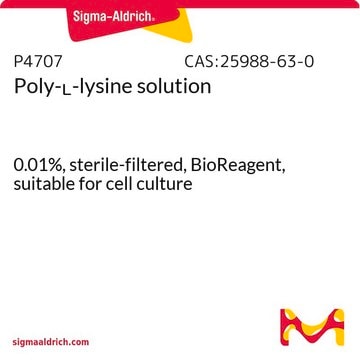A 0.22 µm PES membrane can be used for sterile filtration. Commercially available sterile filtered solutions are available for poly-l-lysine hydrobromide such as item P4707 which may be more convenient.
Wichtige Dokumente
P1274
Poly-L-Lysin -hydrobromid
suitable for cell culture, Mol wt 70,000-150,000 by viscosity
Synonym(e):
L-Lysine homopolymer hydrobromide
Größe auswählen
Größe auswählen
About This Item
Empfohlene Produkte
Produktbezeichnung
Poly-L-Lysin -hydrobromid, mol wt 70,000-150,000 by viscosity
Form
solid
Qualitätsniveau
Mol-Gew.
70,000-150,000 by viscosity
Methode(n)
cell culture | mammalian: suitable
Farbe
white to off-white
Lagertemp.
−20°C
SMILES String
Cl.NCCCCC(N)C(O)=O
InChI
1S/C18H38N6O4/c19-10-4-1-7-13(22)16(25)23-14(8-2-5-11-20)17(26)24-15(18(27)28)9-3-6-12-21/h13-15H,1-12,19-22H2,(H,23,25)(H,24,26)(H,27,28)/t13-,14-,15-/m0/s1
InChIKey
WBSCNDJQPKSPII-KKUMJFAQSA-N
Suchen Sie nach ähnlichen Produkten? Aufrufen Leitfaden zum Produktvergleich
Anwendung
Poly-L-Lysin-Hydrobromid wird für folgende Anwendungen eingesetzt:
- Als Beschichtung in einigen Experimenten mit REF-52-Zellen[1]
- In elektrophysiologischen Experimenten wurden Zellen auf Objektträger aufgebracht, die mit Poly-L-Lysin-Hydrobromid beschichtet oder nicht beschichtet waren[2][3]
- Zellkulturen von Neuronen der Ratte[4]
- Indirekte Bindung monoklonaler Antikörper mittels Poly-L-Lysin[5]
Biochem./physiol. Wirkung
Komponenten
Vorsicht
Angaben zur Herstellung
Hinweis zur Analyse
Lagerklassenschlüssel
11 - Combustible Solids
WGK
WGK 3
Flammpunkt (°F)
Not applicable
Flammpunkt (°C)
Not applicable
Persönliche Schutzausrüstung
Eyeshields, Gloves, type N95 (US)
Hier finden Sie alle aktuellen Versionen:
Analysenzertifikate (COA)
Die passende Version wird nicht angezeigt?
Wenn Sie eine bestimmte Version benötigen, können Sie anhand der Lot- oder Chargennummer nach einem spezifischen Zertifikat suchen.
Besitzen Sie dieses Produkt bereits?
In der Dokumentenbibliothek finden Sie die Dokumentation zu den Produkten, die Sie kürzlich erworben haben.
Kunden haben sich ebenfalls angesehen
Artikel
Kanjiro Miyata (The University of Tokyo, Japan) provides insights on the rational design of polymeric materials for “smart” oligonucleotide delivery.
Humankind has utilized protein materials throughout its existence, starting with the use of materials such as wool and silk for warmth and protection from the elements and continuing with the use of recombinant DNA techniques to synthesize proteins with unique and useful properties.
-
Can the product be sterilised by filtration through a 0.22 µm PES membrane?
1 answer-
Helpful?
-
-
How is shipping temperature determined? And how is it related to the product storage temperature?
1 answer-
Products may be shipped at a different temperature than the recommended long-term storage temperature. If the product quality is sensitive to short-term exposure to conditions other than the recommended long-term storage, it will be shipped on wet or dry-ice. If the product quality is NOT affected by short-term exposure to conditions other than the recommended long-term storage, it will be shipped at ambient temperature. As shipping routes are configured for minimum transit times, shipping at ambient temperature helps control shipping costs for our customers. For more information, please refer to the Storage and Transport Conditions document: https://www.sigmaaldrich.com/deepweb/assets/sigmaaldrich/marketing/global/documents/316/622/storage-transport-conditions-mk.pdf
Helpful?
-
-
How can I determine the shelf life / expiration / retest date of this product?
1 answer-
If this product has an expiration or retest date, it will be shown on the Certificate of Analysis (COA, CofA). If there is no retest or expiration date listed on the product's COA, we do not have suitable stability data to determine a shelf life. For these products, the only date on the COA will be the release date; a retest, expiration, or use-by-date will not be displayed.
For all products, we recommend handling per defined conditions as printed in our product literature and website product descriptions. We recommend that products should be routinely inspected by customers to ensure they perform as expected.
For products without retest or expiration dates, our standard warranty of 1 year from the date of shipment is applicable.
For more information, please refer to the Product Dating Information document: https://www.sigmaaldrich.com/deepweb/assets/sigmaaldrich/marketing/global/documents/449/386/product-dating-information-mk.pdfHelpful?
-
Active Filters
Unser Team von Wissenschaftlern verfügt über Erfahrung in allen Forschungsbereichen einschließlich Life Science, Materialwissenschaften, chemischer Synthese, Chromatographie, Analytik und vielen mehr..
Setzen Sie sich mit dem technischen Dienst in Verbindung.






